Multi-User Detection for Spatial Modulation toward 5G Wireless Communications
2017-04-10ShiwenFanYueXiaoXiaLeiRongShiKeDengShaoqianLi
Shiwen Fan*, Yue Xiao, Xia Lei,2, Rong Shi, Ke Deng, Shaoqian Li
1 National Key Laboratory of Science and Technology on Communications, University of Electronic Science and Technology of China, Chengdu 611731, China
2 The National Mobile Communications Research Laboratory, Southeast University, Nanjing 210096, China
3 Science and Technology on Electronic Information Control Laboratory, the 29th Research Institute of China Electronics Technology Group Corporation, Chengdu 610036, China
I. INTRODUCTION
Spatial modulation (SM) [1]-[10] is a class of potential multi-input multi-output (MIMO)transmission techniques for future wireless communications, which conveys information not only in the transmit antenna, but also in the index of active antenna, so as to make a balanced tradeoff between transmission throughput and computational complexity.Compared to traditional MIMO systems, a unique advantage of SM-MIMO lies in that only one antenna is activated in each time slot, which saves the implement cost for RF chains, especially in the context of massive MIMO ([34]-[37]) in 5G systems. Recently,spatial modulation has been widely considered to be applied in 5G practical systems such as in [31]-[33], because of its advantages of lowcost implement, increased reliability, and power efficiency. The current research progress of SM design includes two aspects: transceiver design without channel state information (CSI)feedback and transceiver design with limited CSI feedback. Specifically, transceiver design without CSI feedback contains transmitter design and low-complexity receiver design. On the other hand, transceiver design with limited CSI feedback contains adaptive modulation,antenna selection, power allocation and link adaptation.
In this paper, a pair of efficient detectors are proposed for multi-user spatial modulation. Specially, a threshold-aided approximate message passing (T-AMP) detector is proposed with the purpose of reducing the computational complexity of traditional structured approximate message passing (Str-AMP) detector.
The detail about the potential application of SM is described as follows. In 5G wireless communications, there will be more equivalent antenna resource for MIMO transmission. SM could be utilized since it can be used in flexible transceiver antenna configuration. SM can be also combined with OFDM for practical system. Single carrier (SC) system, especially with frequency domain equalization (FDE),is usually compared to OFDM for combating frequency selective fading. SM-SC is also a possible technique for 5G communications.
To meet the need of massive connections for the next generation wireless systems [27]-[30], the concept of SM-MIMO should be extended to adapt multi-user scenarios as considered in [11]-[26]. In this situation, the SM signals of multiple user are overlapped in the up/down link of 5G, which introduces the problem of complex signal detection.
Thus, the detection complexity of multi-user SM, is higher in comparison to traditional SM. When the number of active users is moderate, the wide-ranging studies disseminated in [8]-[20] have found a range of detectors designed for multi-user SM systems. For example, in [3], the optimum maximum likelihood(ML) detector jointly detected the antenna index combination and the symbol vector of all the users through the exhaustive search, which imposes intractable complexity, especially when the numbers of users and antennas are large. In order to reduce the complexity of the ML detector, a linear minimum mean-squared error (LMMSE) detector was proposed in [4].As only one antenna is activated for every user in each time slot, the transmitted multi-user SM symbols is sparse. To exploit the sparsity of the transmitted multi-user SM symbols, the compressive sampling (CS)-based detector was proposed in [14] and [15]. Furthermore, a class of approximate message passing (AMP)detectors for multi-user SM systems were proposed in [16]-[18]. Specifically, the detector in [16 and [17] exploits an i.i.d prior on SM transmit signals. And the detector in [18] uses the vector-form of SM transmit signals.
On the other hand, considering future 5G wireless communications with massive connections, the signal detection for multi-user SM-MIMO will become even more difficult.Recently, reference [19] proposed a class of efficient detectors for multi-user SM, termed as structured approximate message passing(Str-AMP) detector, by exploiting the inherent structure of SM signals. It is shown that the performance of the Str-AMP detector is better than traditional detectors as [16]-[18], with lower computational complexity.
For striking a better tradeoff between performance and complexity toward 5G wireless systems, in this paper, a pair of efficient detectors are proposed for the multi-user spatial modulation system. Specially, a threshold-aided AMP detector (T-AMP) is proposed with the purpose of reducing the computational complexity of the Str-AMP detector. The threshold is employed to determine whether the estimated signal at each iteration is reliable. In addition, a novel probability ranking aided approximate message passing detector is proposed for multi-user spatial modulation system. The so-called probability-ranking-aided AMP (P-AMP) detector is proposed with the purpose of improving the performance of traditional Str-AMP detector. Specifically,the probability ranking is used to get a signal search space in the P-AMP detector. Then we can obtain the optimum result from the signal search space. In conclusion, the P-AMP detector are capable of achieving better system performance than Str-AMP from the signal space. Simulation results show that T-AMP detector is able to achieve similar performance as Str-AMP with lower complexity, while the proposed P-AMP detector exhibits a better symbol error rate (SER) performance with similar complexity.
The remainder of this paper is organized as follows. In Section II, a brief overview of the system model and the Str-AMP detector for multi-user SM systems is given. In Section III,the proposed T-AMP detector and P-AMP detector are introduced. Section IV presents the simulation results. Finally, concluding remarks are drawn in Section V.
II. MULTI-USER SM SYSTEM
2.1 Transmitter model and str-AMP detector
Assume that the multi-user SM system has Kusers, each user has Nttransmit antennas and only one transmit antenna is activated for transmitting symbol. We also assume that there are Nrreceive antennas at the base station (BS). The number of total transmit antenna combinations (TAC) for every user is Nt. Hence, in each time slot for every user, the first block of l1=log2Ntbits is assigned to select a transmit antenna combination index j(j∈(1,Nt)), while the second block ofbits is used to modulate M-PSK/QAM symbols. We assumedenotes the bits of the k-th user. Specifically,the first partof bkis mapped to the activated index j of user k, the second partof b is mapped to thekconstellation symbol xkj. Then the SM transmit vector of user k can be expressed as

where xkindicates the transmit vector of user k. And xkjindicate the M-PSK/QAM constellation symbols of user k, it denotes the j-th element of xk. At this time, only the j-th transmit antenna is activated. In conclusion,only one transmit is activated in each time slot for every user.
Repeat the above coding progress, the transmit vector of all the users can be denoted as

Assume the transmit signals x go through the block Rayleigh fading channeldenotes the channel matrix between the k-th user and the BS, the elementofobeys the Gaussian distribution CN(0,1), where j∈{1,2,…,Nt} and a∈{1,2,…,Nr}. Then the a-th received signal yain the BS can be formulated as

where nadenote the Additive White Gaussian Noise (AWGN) with the mean 0 and the variance σ2.
The model of (3) can be rewritten as vector form

In [14], a detector named Str-AMP is proposed. The Str-AMP detector obtains the mean and the variance of the symbols through that it treats the transmitted antenna as a Gaussian random variable by AMP framework [22].Specially, based on (4), we can obtain



In conclusion, we can update the estimation of xiiteratively through AMP detector. After the maximum iterations T1is reached, the final resultis got.
2.2 Proposed T-AMP and P-AMP detectors for multi-user SM System
A threshold-aided AMP (T-AMP) detector is proposed to maintain the same SER performance of the Str-AMP detector with lower complexity. In the proposed T-AMP detector,a threshold is employed to determine whether the estimated signalˆ obtained from pi(x)at each iteration is reliable. Specifically, if the Euclidean distance (ED) of xˆ is inside the threshold, this output xˆ is taken as the final result. Otherwise, the iterative progress continues. Therefore, we can reduce the complexity of Str-AMP detector by introducing the threshold. The details of the proposed T-AMP detector is described as follows.
1) As only one transmit antenna is activated for transmitting symbol in each user,we initialize the probability vector pi(x ) of the i-th transmit antenna in the first timewhere x∈s anddenote the M-QAM or M-PSK modulation alphabet. On the other hand, we initialize the messagesandfor the j-th receive antenna, where yjdenotes the j-th element of y, j=1,...,Nr.



where Hjidenote the (j,i)th element of H.


6) Update the probability vectorof the i-th transmit antenna in the (t+1)-th iteration as follows,
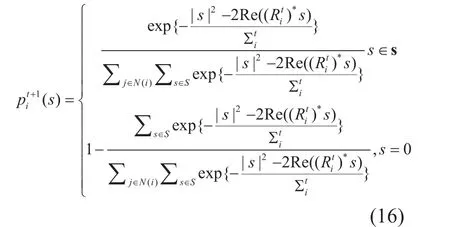
7) For each transmit antenna i∈{1,2,...,N}, the probability vector
tcan be expressed as

The estimated index h(h∈[1,2,...,M +1])denotes as the index for transmit antenna i can be given by the index of the max value of probability vector
Therefore, the estimated symbolfor transmit antenna i.
The estimated signal xˆ of all the users can be denoted by traversing all the transmit antenna index as follows

8) Then the output xˆ is considered as the final output if the Euclidean Distance (ED) of xˆ satisfies
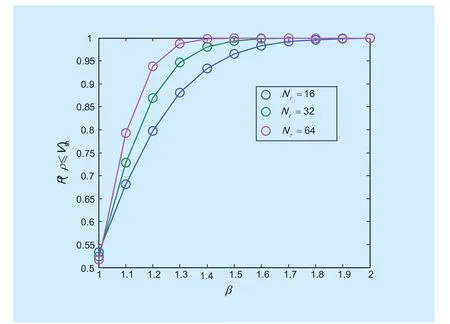
Fig. 1 with different parameters β

Fig. 2 SER with different parameters β

Otherwise, the next t+1-th iteration is executed to begin with step 2. The above iterative process is stopped until the number of iterations reaches a fixed maximum number or we have satisfied (19).
From step 8 of T-AMP, it can be seen that the value of β in the threshold Vthhighly affects the performance of T-AMP. Because the value of Vthcan decide the number of iterations. The selection of the value β in our proposed detector for multi-user SM system is derived as follows.
If we have gotten the right estimated signalcan be simplified asBased on the statistic, in multi-user SM, sincefollows a Chi-squared distribution with 2Nrdegrees of freedom, the probabilitycan be denoted as


In conclusion, we can select an appropriate β from the range of 1≤β≤2 which is capable of achieving the expected complexity and SER performance for a specific multi-user SM.
2.3 Proposed P-AMP detector
In this subsection, a search space Ω from pi(s ) through probability ranking is employed in the proposed P-AMP detector after the iterative progress of AMP detector for getting a better SER performance. Then we can obtain the estimated modulated symbols sΛiby comparing the probability pi(s ).
After traversing the search space Ω, the final result of estimated TAC and symbol (Λ~,s~)can be obtained. The details of the proposed P-AMP detector are described as follows.
1) First, from (16), we can obtain the probability vector, which denotes as different constellational symbols at every transmit antenna. The active probability vector P of transmit antennas is obtained by

2) For each user k, we choose the second largest transmit antenna index kcof the active probability vectorof transmit antennas as the candidate. After traversing all the users, the candidate C1can be formulated as

Then the ordered user indices W can be obtained by

The new candidate set C1is obtained by retaining the first m elements of W as

For these m users in C1, we have two choices. Specifically, we can choose the largest transmit index or the second largest index wmas the activated index. Thus there are 2mpossible activated transmit combinations for all the users, which can be described as. We assume the r-th activated transmit antenna combination(r=1,2,...,R ), wheredenote the activated transmit antennas index of the user k. Thus the estimated modulate symbol sdrkin the drk-th transmit antenna of user k can be obtained by

Then the estimated modulate symbol sdrkof activated transmit antenna combination Ω is formulated as

Finally, the output estimated TAC and symbols () can be expressed as

2.4 Complexity analysis
In this subsection, we can analyzed the complexity of the proposed algorithms based on real-valued flops, which can be denoted as a real-valued multiplication or addition.
For specific matrices A∈ℂm×n, B∈ℂn×p,C ∈ ℂn×1and, the operations of AB,andrequire 8mnp−2mp,4n−1, and 2n flops, respectively.
Accordingly, the complexity of the Str-AMP detectorCS, the T-AMP detector CT, the P-AMP detector CPcan be computed by (27),(28) and (29).


The terms assigned numbers in (27), (28),(29) denote the corresponding equation in this letter. Specifically, the first part of (27) means that the complexity calculation of (10), the same meaning can be found in other part.
The details of the complexity of the Str-AMP detector, the T-AMP detector and the P-AMP detector is given as follows. The complexity of Str-AMP detector CSis mainly invoked by (6)-(7), and (10)-(15) in the paper.
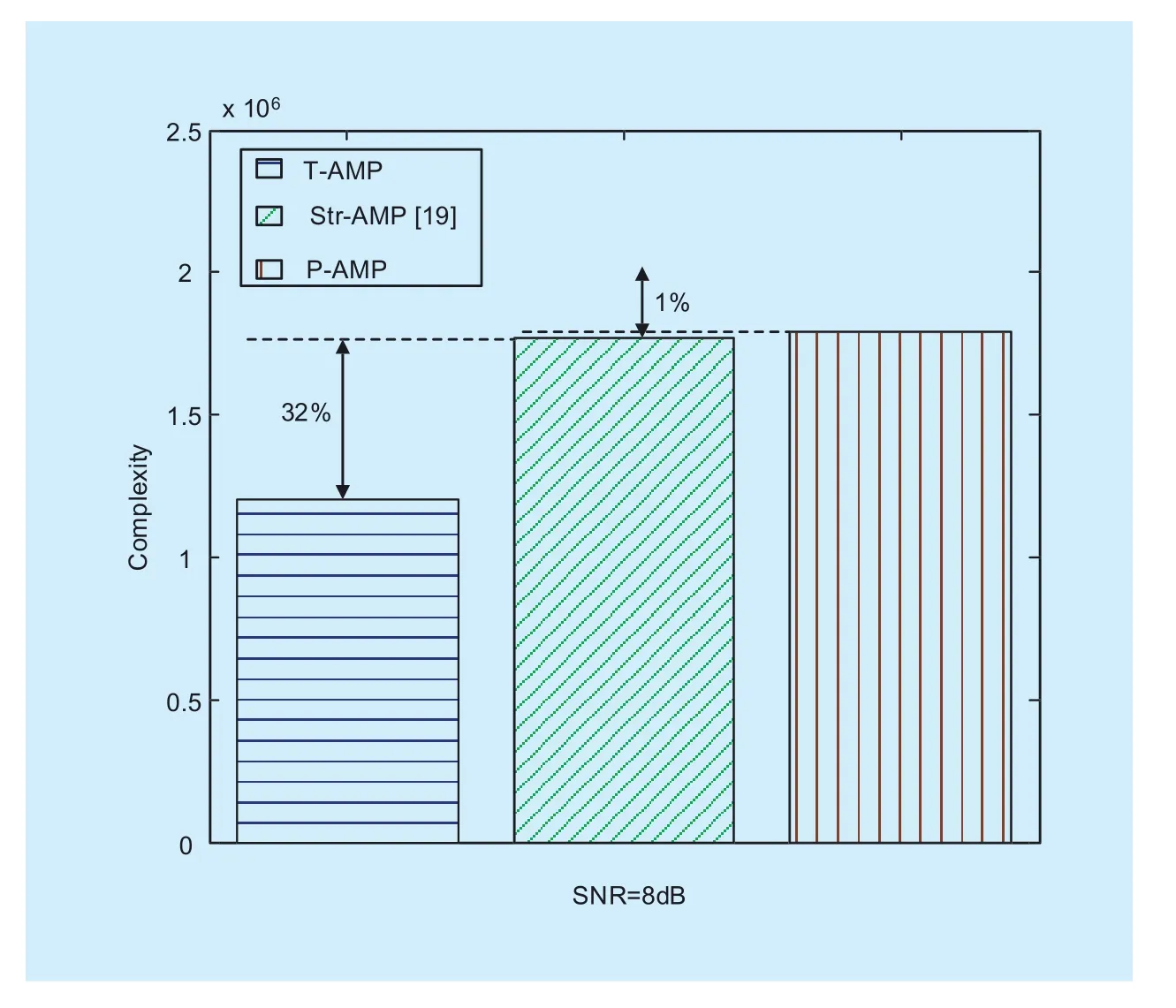
Fig. 3 Complexity comparison between the proposed and existing detectors for multi-user SM systems with K=16, Nt=4, Nr=64, m=4

In general, the Str-AMP detector is a iterative process of (6)-(7) and (10)-(15), and we denote T1as the iterative number of the Str-AMP detector. Hence, the complexity of Str-AMP detector CSis denoted by (27).
The complexity of T-AMP detector CTis mainly invoked by (8)-(16) and (19) in the paper. The complexity of (10)-(15) is described in the above calculation. The complexity of(8)-(9), (16) and (19) is described as follows.
Hence, the complexity of T-AMP detector CTis denoted by (27).
The complexity of P-AMP detector CPis mainly invoked by (6)-(7), (10)-(15) and (26)in the paper. The complexity of (6)-(7) and(10)-(15) is described in the above calculation.
Hence, the complexity of P-AMP detector is denoted by (28).
Figure 3 compares the complexity of the proposed T-AMP detector, the proposed P-AMP detector and the Str-AMP detector for the QPSK-aided multi-user SM systems with K=16, Nt=4 and Nr=64 As shown in figure 2, the proposed P-AMP detector can achieve 32% complexity reduction over the Str-AMP detector. The complexity of the proposed P-AMP detector is almost same to the Str-AMP detector.
Figure 4 compares the complexity of the proposed T-AMP detector, the proposed P-AMP detector and the Str-AMP detector for the QPSK-aided multi-user SM systems withK=32, Nt=2 and Nr=64. As shown in figure 4, the proposed P-AMP detector can achieve 26% complexity reduction over the Str-AMP detector. The complexity of the proposed P-AMP detector is similar to the Str-AMP detector.
III. SIMULATION RESULTS
In this section, we have compared the symbol error rate (SER) performance and the complexity of the proposed and the conventional Str-AMP detectors for multi-user SM systems.In our comparisons, we utilize the β=1 [21]and T1=T2=15 in the proposed detectors.The Orthogonal Frequency Division Multiplexing (OFDM) framework is considered in our MIMO setups, thus the Rayleigh fading channel is employed.
Figure 5 compares the SER performance of the proposed T-AMP detector, the proposed P-AMP detector and the Str-AMP detector for the QPSK-aided multi-user SM systems with K=16,Nt=4 and Nr=64. As shown in figure 5, the proposed T-AMP detector is capable of providing similar performance as Str-AMP detector. The proposed P-AMP detector is capable of providing better performance as AMP detector with similar complexity over the Str-AMP detector.
Figure 6 compares the SER performance of the proposed T-AMP detector, the proposed P-AMP detector and the Str-AMP detector for the QPSK-aided multi-user SM systems with K=32,Nt=2 and Nr=64. We show that the proposed T-AMP detector is capable of providing similar performance as Str-AMP detector. The proposed P-AMP detector can provide better performance as AMP detector with similar complexity over the Str-AMP detector..
IV. CONCLUSIO N
In this paper, toward 5G wireless communications and multi-user spatial modulation, two class of novel detectors, namely T-AMP and P-AMP, were proposed for achieving a balanced tradeoff between system performance and computational complexity. We show that the proposed T-AMP detector was capable of achieving similar performance as traditional Str-AMP detector with lower complexity. On the other hand, the proposed P-AMP detector was able to achieve better performance with similar complexity.
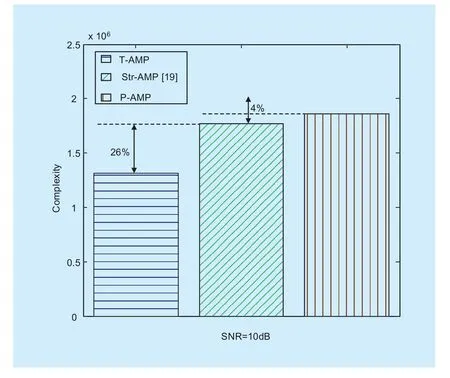
Fig. 4 Complexity comparison between the proposed and existing detectors for multi-user SM systems with K=32, Nt=2, Nr=64, m=4
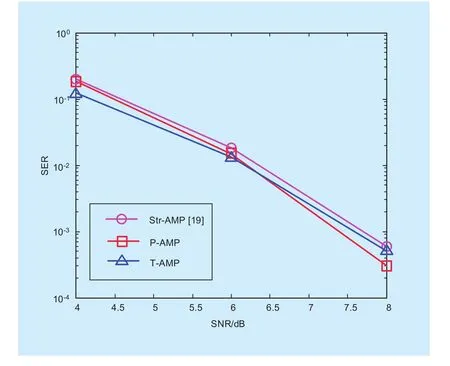
Fig. 5 SER performance between the proposed and existing detectors for multi-user SM systems with K=16, Nt=4, Nr=64, m=4

Fig. 6 SER performance between the proposed and existing detectors for multi-user SM systems with K=32, Nt=2, Nr=64, m=4
ACKNOWLEDGEMENT
The financial support is gratefully acknowledged by the National Science Foundation of China under Grant numbers 61471090, the Open Research Fund of National Mobile Communications Research Laboratory,Southeast University (No.2015D09), the Foundation Project of Science and Technology on Electronic Information Control Laboratory under Grant JS17041403811 (201606071370-004-001), and the Foundation Project of National Key Lab. of Sci. and Tech. on Comm. under Grant 6142102010702.
[1] P. Yang, M. D. Renzo, L. Hanzo, et al. Single-Carrier SM-MIMO: A promising design for broadband large-scale antenna systems[J]. IEEE Communications Surveys Tutorials, 2016, 18(2),1687-1716.
[2] M. Di Renzo, H. Haas, A. Ghrayeb, S. Sugiura,L. Hanzo. Spatial modulation for generalized MIMO: Challenges, opportunities, and implementation[J]. Proc IEEE, 2014, 102(1), 56-103.
[3] J. Jeganathan, A. Ghrayeb, L. Szczecinski. Spatial modulation: optimal detection and performance analysis[J]. IEEE Commun. Lett., 2008,12(8), 545-547.
[4] M. Di Renzo, H. Haas, P. M. Grant. Spatial modulation for multiple-antenna wireless systems:a survey[J]. IEEE Commun. Mag, 2011, 49(12),182-191.
[5] R. Mesleh, H. Haas, S. Sinanovic, C. W. Ahn,S. Yun. Spatial modulation[J]. IEEE Trans. Veh.Technol, 2008, 57(4), 2228-224.
[6] P. Yang, M. Di Renzo, Y. Xiao, S. Li, L. Hanzo. Design guidelines for spatial modulation[J]. IEEE Commun. Surv. Tuts.,2015, 17(1), 6-26.
[7] Y. Yang, B. Jiao. Information-guided channel-hopping for high data rate wireless communication. IEEE Commun. Lett., 2008, 12(4),225-227.
[8] R. Y. Mesleh, M. Di Renzo, H. Haas, P. M. Grant.Trellis coded spatial modulation[J]. IEEE Trans.Wireless Commun., 2010, 9(7), 2349-2361.
[9] R. Mesleh, H. Elgala, H. Haas. Optical spatial modulation,[J]. IEEE/OSA J. Opt. Commun.Netw., 2011, 3(3),. 234-244.
[10] M. Di Renzo, H. Haas. Bit error probability of SM-MIMO over generalized fading channels[J].IEEE Trans. Veh. Technol., 2012, 61(3), 1124-1144.
[11] P. Raviteja, T. L. Narasimhan, A. Chockalingam.Mulituser sm-mimo versus massive mimo:Uplink performance comparison[J]. Computer Science., 2013.
[12] T. L. Narasimhan, A. Chockalingam. Channel hardening-exploiting message passing (CHEMP)receiver in large-scale MIMO systems[J]. IEEE J.Sel. Topics Signal Process., 2014, 8(5), 847-860.
[13] T. L. Narasimhan, P. Raviteja, A. Chockalingam,Generalized spatial modulation in large-scale multiuser MIMO systems[J]. IEEE Trans. Wireless Commun., 2015, 14(7), 3764-3779.
[14] A. Garcia-Rodriguez, C. Masouros. Low-complexity compressive sensing detection for multi-user spatial modulation systems[C]. IEEE International Conference on Acoustics, Speech and Signal Processing (ICASSP), 2015.
[15] A. Garcia-Rodriguez, C. Masouros. Low-complexity Compressive Sensing Detection for Spatial Modulation in Large-Scale Multiple Access Channels[J]. IEEE Trans. Commun., 2015, 63(7),2565-2579.
[16] S. Wang, Y. Li, J, J. Wang, M. Zhao. Low-complexity multiuser detection in massive spatial modulation MIMO[C]. IEEE Globecom, 2014,1-5.
[17] S. Wang, Y. Li, J, M. Zhao, J. Wang. Energy-effi-cient and low-complexity uplink transceiver for massive spatial modulation MIMO[J]. IEEE Trans.Veh. Technol., 2015, 64(10), 4617-4632.
[18] S. Wang, Y. Li, J. Wang. Multiuser detection in massive spatial modulation mimo with low-resolution adcs[J]. IEEE Trans. Wireless Commun.,2015,14(4), 2156-2168.
[19] X. Meng, S. Wu, J, L. Kuang, D. Huang, J. Lu.Multi-user detection for spatial modulation via structured approximate message passing[J].IEEE Commun. Lett., 2016, 20(8), 1527-1530.
[20] P. Raviteja, T. L. Narasimhan, A. Chockalingam.Detection in large scale multiuser SM-MIMO systems: Algorithms and performance[C]. Proc.IEEE Veh. Technol. Conf. (VTC’14-Spring), 2014,1-5.
[21] L. Xiao, P. Yang, Y. Xiao, S. Fan, M. Renzo, W.Xiang, S. Li. Efficient compressive sensing detectors for generalized spatial modulation systems[J]. IEEE Trans. Veh. Technol., 2017, 66(2),1284-1298.
[22] D. L. Donoho, A. Maleki, A. Montanari. Message-passing algorithms for compressed sensing[J]. Proc. Nat. Acad. Sci, 2009, 106(45),18914-18919.
[23] D. Wang, Y. Zhang, H. Wei, et al. An overview of transmission theory and techniques of largescale antenna systems for 5G wireless communications[J]. [Online]. Available: http://arxiv.org/abs/1605.03416
[24] S. Uluocak, E. Basar, Spatial modulation for multi-user massive MIMO systems[C]. Signal Processing and Communications Applications Conference (SIU), 2017.
[25] L. He, J. Wang, et al. Bandwidth Efficiency Maximization for Single-Cell Massive Spatial Modulation MIMO: An Adaptive Power Allocation Perspective[J]. IEEE Access, 2017, 5, 1482-1495.
[26] L. He, J. Wang, J. Song, L. Hanzo. On the multi-user, multi-cell massive spatial modulation uplink: How many antennas for each user?[J]. IEEE Trans. Wireless Commun., in press,doi: 10.1109/TWC.2016.2645201.
[27] J. Andrews et al, ``What Will 5G be?[J]. IEEE JSAC, 2014, 32(6), 1065-1082.
[28] C. Wang, F. Haider, X. Gao, X. You, Y. Yang, D.Yuan, H. Aggoune, H. Haas, S. Fletecher, E.Hepsaydir. Cellular Architecture and Key Technologies for 5G Wireless Communication Networks[J]. IEEE Commun. Mag., 2014, 52(2), 122-130.
[29] C.-Lin, C. Rowell, S. Han, Z. Xu, G. Li, Z. Pan. Toward Green and Soft: A 5G Perspective[J]. IEEE Commun. Mag., 2014, 52(2), 66-73.
[30] V. Jungnickel, K. Manolakis, W. Zirwas, B.Panzner, V. Braun, M. Lossow, M. Sternad, R.Apelfrojd, T. Svensson. The Role of Small Cells,Coordinated Multipoint, and Massive MIMO in 5G[J]. IEEE Commun. Mag., 2014, 52(5), 44-51..
[31] E. Basar. Index modulation techniques for 5G wireless networks[J]. IEEE Commun. Mag., 2016,54(7): 168-175.
[32] P. Patcharamaneepakorn, S. Wu, C. X. Wang, et al. Spectral, energy, and economic efficiency of 5G multicell massive MIMO systems with generalized spatial modulation[J]. IEEE Trans. Veh..Technol., 2016, 65(12): 9715-9731.
[33] Y. Xiao, L. Xiao, L. Dan, et al. Spatial modulaiton for 5G MIMO communications[C]. IEEE Digital Signal Processing (DSP), 2014 19th International Conference, 847-851.
[34] X. Li, T. Jiang, S. Cui, J. An, and Q. Zhang. Cooperative Communications Based on Rateless Network Coding in Distributed MIMO Systems[J].IEEE Wireless Communications, June., 2010,17(3), 60-67.
[35] H. Xie, F. Gao, S. Zhang, S. Jin. A unified transmission strategy for TDD/FDD massive MIMO systems with spatial basis expansion model[J].IEEE Trans. Veh. Technol., Apr., 2017, 66(4),3170-3184.
[36] H. Xie, F. Gao, and S. Jin. An overview of lowrank channel estimation for massive MIMO systems[J]. IEEE Access. Nov., 2016, 4, 7313--7321.
[37] W. Feng, Y. Wang, D. Lin, N. Ge, J. Lu, and S. Li.When mmWave Communications Meet Network Densification: A Scalable Interference Coordination Perspective[J]. IEEE Journal on Selected Areas in Comm., Jul., 2017, 35(7).
杂志排行
China Communications的其它文章
- On Uplink Non-Orthogonal Multiple Access for 5G:Opportunities and Challenges
- Clustering of Virtual Network Function Instances Oriented to Compatibility in 5G Network
- Contract-Based Content Delivery in 5G Converged Networks
- Radio Access Network Slicing Based on C/U Plane Separation
- Resource Allocation in D2D-Aided High-Speed Railway Wireless Communication Systems: A Matching Theory Approach
- Symbol Error Rate Performance Analysis of Non-Orthogonal Multiple Access for Visible Light Communications
